May 24, 2025 | 16:25 GMT +7
May 24, 2025 | 16:25 GMT +7
Hotline: 0913.378.918
May 24, 2025 | 16:25 GMT +7
Hotline: 0913.378.918
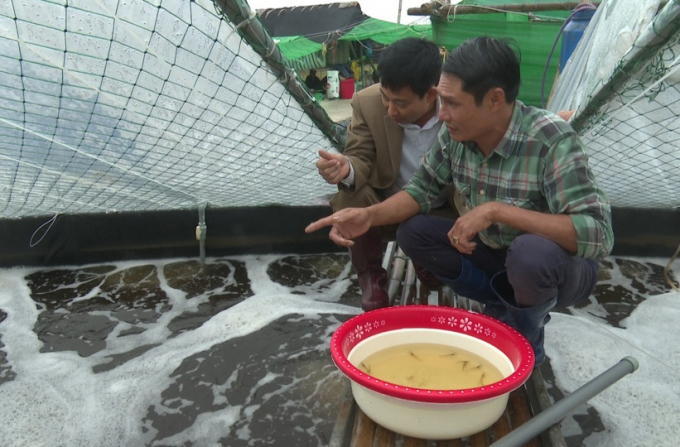
According to Mr. Dao Xuan Tu, Tan Hung 2 village, Nam Thang commune (Tien Hai, Thai Binh), to successfully raise high-tech shrimp, you must ensure that the shrimp seed is disease-free, the water is clean, the pond bottom is clean. Photo: TQ.
In recent years, farmers of Tien Hai district (Thai Binh) have actively renovated ponds, invested in equipment, facilities, technical training, etc., developed high-tech shrimp farming and initially brought about very positive results.
Ms. Nguyen Thi Hong, Deputy Head of Tien Hai Department of Agriculture and Rural Development, said: In 2021, the total aquaculture area of the district is over 5,000 hectares, the output is over 69,900 tons (up by 4.1% over the same period last year).
Regarding shrimp farming, the whole district raises 261 million shrimp seed, the whiteleg shrimp farming area is nearly 270ha. In which, the area of high-tech shrimp farming is over 95 hectares, concentrated mainly in Dong Minh, Nam Thinh, Nam Cuong and Nam Thang communes.
According to Ms. Hong, high-tech shrimp farming helps farmers improve productivity and quality thanks to the control over the entire farming process, especially the water source. Accordingly, the high-tech shrimp farming system is a scientific combination and arrangement between the main pond and auxiliary ponds such as settling ponds, treatment ponds, preparation ponds, wastewater treatment systems...
In addition, with this farming method, shrimp ponds are not dependent on the weather thanks to the mesh or plastic roof system folowing the characteristics of each farming crop, reducing the risk of diseases during the farming process, shrimp farming wastewater is treated before being discharged helps to protect the water source and the surrounding environment... As a result, it contributes to improving the quality, output and selling price of commercial shrimp, increasing profits for farming households compared to previously applied traditional farming methods.
Visiting the shrimp farming area in Nam Cuong and Nam Thang communes (Tien Hai), in contrast to the intensive and semi-intensive shrimp farming households in earthen ponds, who are urgently renovating and cleaning the ponds after the winter break in preparation for the new season, the high-tech shrimp ponds are still full of shrimp, bustling with buyers and sellers.
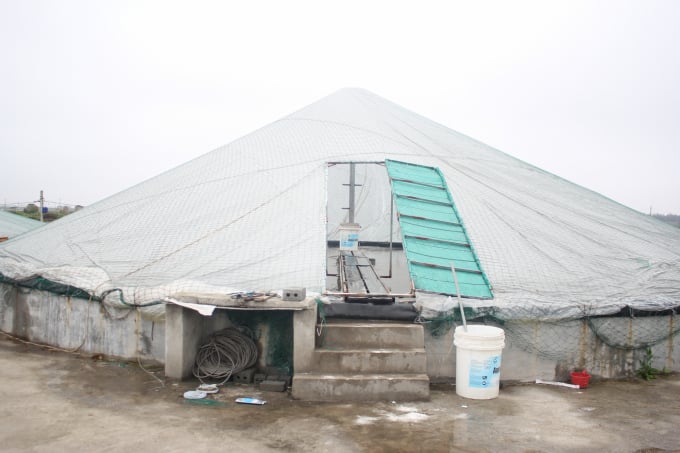
The main pond must be lined with tarpaulin, covered with an oxygen fan, etc. Additionally, the auxiliary pond, water supply and drainage system also need to be methodically invested with scientific arrangement. Photo: Trung Quan.
Mr. Dao Xuan Tu, Tan Hung 2 village, Nam Thang commune (Tien Hai, Thai Binh) shared: To successfully raise high-tech shrimp, many factors need to be considered, of which the initial investment costs and farming techniques are two key factors, playing a decisive role in success or failure.
Tu explained, when using high technology, excluding the cost of seed, farmers not only have to invest in equipment for the main pond, but the auxiliary pond system must also be fully equipped. If one part does not meet the standards, the entire system will not be able to operate following the technical process.
Mr. Tu gave an example, on an area of 1,700m2, his family built 2 commercial shrimp farming tanks with an area of 500m2/tank, 2 hatching tanks, 5 auxiliary ponds with a total investment of more than 1 billion VND. This is all the capital he has accumulated over many years to build a house, but he chose to live in a temporary shack next to the pond to save the money for investment.
Technical-wise, according to Mr. Tu, high-tech shrimp farming requires farmers to firmly grasp the technical requirements, strictly follow procedures, ensure the "3 clean", which is disease-free shrimp seed, clean water, clean pond bottom.
Accordingly, the pond is designed in a circular shape, lined with tarpaulin to help the fan create a vortex, generating greater centrifugal force, easily push the waste, peeled shrimp carcass, shrimp feces into the siphon pit in the middle of the pond. Cleaning ponds can be done easily and quickly as a result. The pond bottom is controlled throughout the growing season to help minimize harmful bacteria and toxic gas outbreaks. Thereby, reducing the cost of chemicals used to treat the environment, ensuring the quality of pond water for shrimp growth and development.
The top of the pond must have a roof system suitable to the weather in each season of the year to limit the entry of animals, insects, dirt and stabilize the temperature in the pond in winter... this will contribute to limiting pathogens, overcoming mass mortality of shrimp when seeding.
In addition, the advantage of high-tech shrimp farming is that it can be farmed with a density of 300-400 shrimp/m2. However, the density must be distributed in accordance with the growth and development stages of the shrimp.
“Usually, the period of shrimp larvae rearing lasts 25 to 30 days at a density of 2,000 shrimp/m2, then moving to ponds with a density of 400 shrimp/m2, then down to 200 shrimp/m2. After the shrimps reach the size of 36-38 shrimp/kg, farmers start selling and pruning to raise 100 shrimp/m2, when the shrimps go down to 27-32 shrimp/kg, farmers collect all of them”, Mr. Tu shared.

Mr. Nguyen Van Chuc, Chi Cuong village, Nam Cuong commune (Tien Hai, Thai Binh) is excited because high-tech shrimp farming can be raised in crop 3 (winter crop), so that the output, shrimp selling price, income are also higher. Photo: Trung Quan.
Mr. Nguyen Van Chuc, Chi Cuong village, Nam Cuong commune (Tien Hai, Thai Binh) said: The total area using high-tech shrimp farming is 2 acres, including 1,650 m2 reserved for building ponds, the remaining is for auxiliary works.
According to Mr. Chuc, farming following the traditional method, he can only raise 2 crops/year, but with high-tech farming, it is possible to raise more off-season shrimp (shrimp in winter or crop 3), which helps farmers increase yield. In particular, the selling price of shrimp in the winter crop is much higher than in that of the two main crops.
Particularly, his family's pond has an area of 500m2 with an average yield of 4-5 tons/crop (traditional farming method only yields 2-3 quintals/crop). With the selling price of shrimp in the winter crop reaching 220,000-250,000 VND/kg (main season price is only 150,000 to 160,000 VND/kg), his family earned 800-850 million VND/crop, after deducting profitable expenses, they earn 300-350 million/crop.
Mr. Do Duc Thien, Director of Nam Cuong Agricultural Service Business Cooperative, Nam Cuong Commune (Tien Hai, Thai Binh) excitedly shared: The total area of aquaculture in the commune is 86 hectares, of which, there are 30 hectares of shrimp farming following traditional methods, 3 hectares of high-tech shrimp farming, the remaining is for clam breeding.
In the near future, the area of high-tech shrimp farming of farmers in the commune will certainly increase, because the households have observed and compared the effectiveness of this new farming method with the traditional ones.
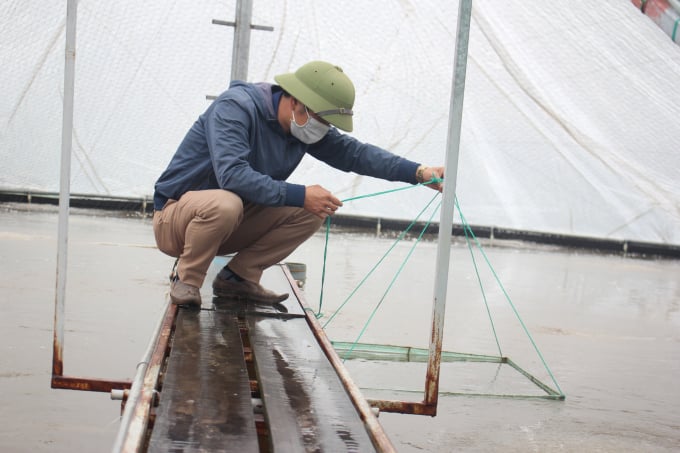
According to Mr. Do Duc Thien, Director of Nam Cuong Agricultural Service Business Cooperative, Nam Cuong commune, (Tien Hai, Thai Binh), high-tech shrimp farming will be a sustainable development direction for shrimp farming households in the commune. Photo: Trung Quan.
According to Mr. Thien, although initial investment cost is high, the equipment can be used for a long time, can easily be repaired, replaced and moved when necessary. In addition, with the advantage of limiting the impact of external conditions, increasing the farming crop, controlling the entire growth and development process of shrimp, the successful rate of farming is over 90%. As such, farmers have increased their incomes and have had surplus funds to reinvest in production expansion.
Ms. Nguyen Thi Hong, Deputy Head of Tien Hai Department of Agriculture and Rural Development, said: From the results through practice, it shows that high-tech shrimp farming is opening an effective and promising direction for shrimp farmers in the area. In the future, to encourage and support farmers to convert and expand high-tech shrimp farming areas, management agencies from districts to communes will create all favorable conditions for infrastructure, provide technical training, coordinate with banks to help farmers access capital at the lowest interest rates, create motivation for households to feel secure in production, increase profits and stabilize their lives.
Translated by Nguyen Hai Long
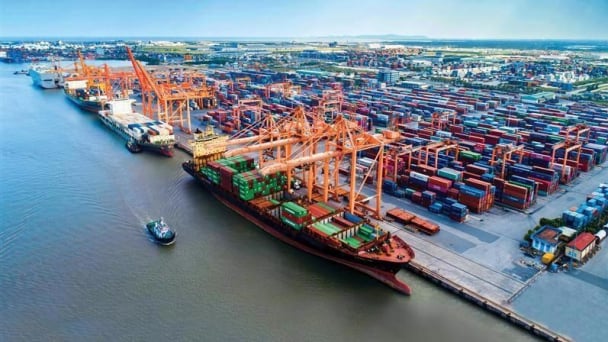
(VAN) South Korea is currently the second-largest investor in Hai Phong in terms of the number of projects (186 projects) and the largest in terms of total registered investment capital, reaching USD 14.2 billion.
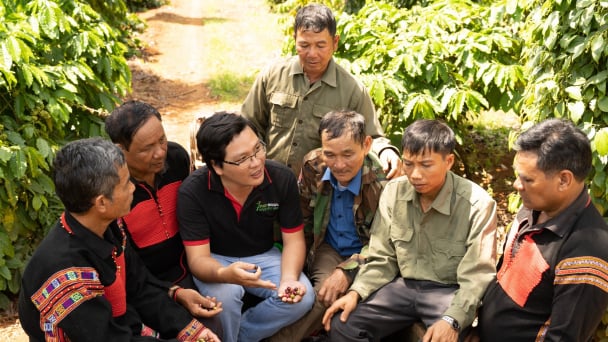
(VAN) As consumers become more environmentally conscious, legal regulations grow increasingly stringent...
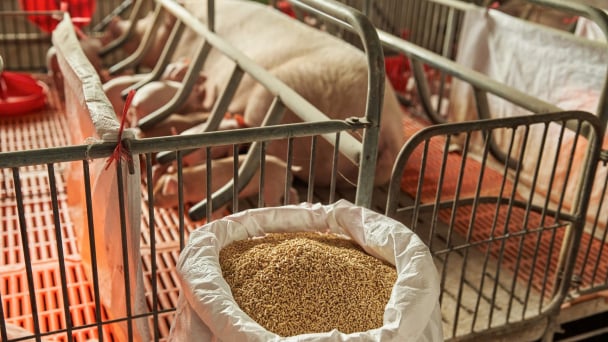
(VAN) CJ Feed&Care officially launched the FCR improvement campaign called “2025 Find Challenge Reach” in April 2025. In Vietnam, this campaign is implemented by CJ Vina Agri.
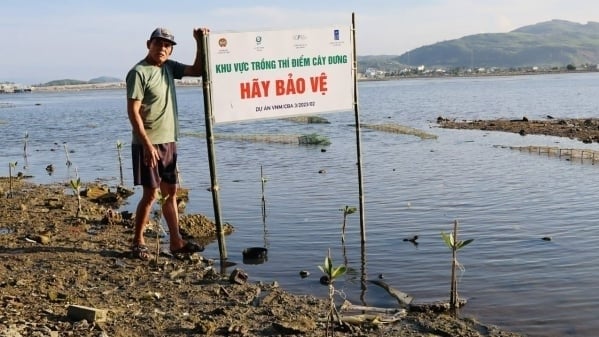
(VAN) The swamp in Pho Thanh is gradually being covered with red mangrove, creating a favorable environment for producing clean, high-quality salt.

(VAN) The trade turnover of agro-forestry-fishery products is growing significantly, along with investment cooperation commitments that are opening up new development directions between Vietnam and Russia.
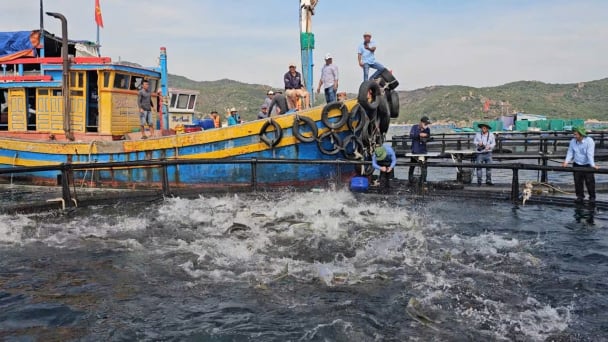
(VAN) Khanh Hoa is investing over 545 billion VND to develop 240 hectares of high-tech marine aquaculture in order to guarantee a consistent supply of seafood exports and achieve the USD 1 billion target.
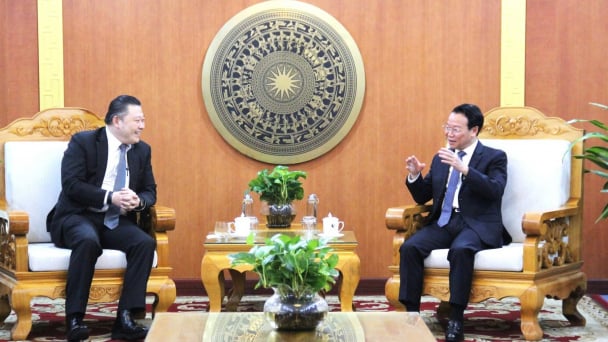
(VAN) Minister of Agriculture and Environment Do Duc Duy held a meeting with Soopakij Chearavanont, Chairman of C.P. Group, on May 15.